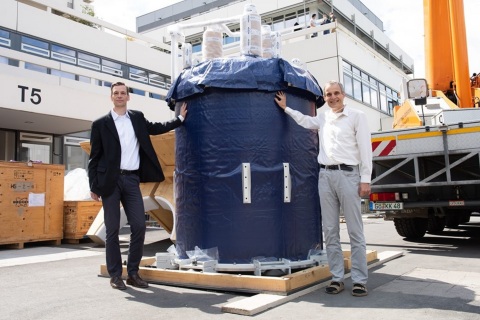
BILLERICA, Mass.– Bruker Corporation (Nasdaq: BRKR) today announced that three world-leading institutions are now accelerating their research into functional structural biology and human disease with new Bruker ultra-high field nuclear magnetic resonance (NMR) spectrometers installed in 2020. Novel GHz-class NMR technology enables advanced research to obtain structural, functional and binding information of intrinsically disordered proteins (IDPs), and of partially structured proteins with key intrinsically disordered regions (IDRs), at atomic resolution under near-physiological conditions. For example, these new technological and methods capabilities now accelerate research into viral-host interactions and viral replication, as well as into proteins that are linked to neurodegenerative diseases.
The recent installation of a 1.2 GHz NMR spectrometer at the Max Planck Institute for Biophysical Chemistry in Goettingen, has already enabled their research teams to deliver new insights into the SARS-CoV-2 nucleocapsid (N) protein, and it is set to aid the deeper molecular understanding of Parkinson’s and Alzheimer’s diseases.
Bruker’s 1.2 GHz NMR magnets utilize a novel hybrid technology with high-temperature superconductor (HTS) inserts in low-temperature superconductor outer sections. The Ascend™ 1.2 GHz magnets are stable, homogenous, standard-bore (54 mm) magnets suitable for high-resolution and solid-state NMR.
Using ultra-high field NMR, scientists at the Max Planck Institute (MPI) and the German Center for Neurodegenerative Diseases (DZNE) have shown that the SARS-CoV-2 N protein and host ribonucleic acids (RNA) jointly condense into tiny droplets akin to membraneless organelles, when the virus enters a host cell. This fast liquid-liquid phase separation (LLPS) inside the cytoplasm of the host cell is a characteristic capability of IDPs and IDRs, and sheds new light on how the virus replicates, and offers new targets for drug development.
Professor Christian Griesinger, Director and Scientific Member at the Max Planck Institute for Biophysical Chemistry in Goettingen, commented: “The new 1.2 GHz spectrometer will allow us to characterize droplets and oligomers of IDPs that are key markers in diseases such as COVID-19, neurodegenerative diseases and cancer, and which cannot be studied using crystallography or cryo-EM.”
Dr. Markus Zweckstetter, Professor at the University of Goettingen and Group Leader at the German Center for Neurodegenerative Diseases, added: “Our first experiments after the installation of the new ultra-high field NMR system have focused on the SARS-CoV-2 nucleocapsid N-protein that is of key relevance for viral-host interactions and viral replication biology. The liquid-like properties of viral replication machineries in combination with the many intrinsically disordered regions of the N-protein make this research ideally suited for GHz-class NMR.”
Dr. Falko Busse, President of the Bruker BioSpin Group stated: “The fourth quarter acceptance at the Max Planck Institute follows installations of two 1.2 GHz NMRs at CERM (University of Florence) and at ETH Zuerich earlier in 2020. We are proud to provide enabling technology for pushing the boundaries in functional structural biology and advanced materials science.”
Dr. Busse continued: “We are also pleased that in December 2020, we have received an order for a second Swiss 1.2 GHz system from a consortium of the University of Zuerich, ETH Zuerich and the Biozentrum of the University of Basel. For 2021, we anticipate the installation of 4-5 GHz-class NMRs, as we have used 2020 to ramp our capacity.”


